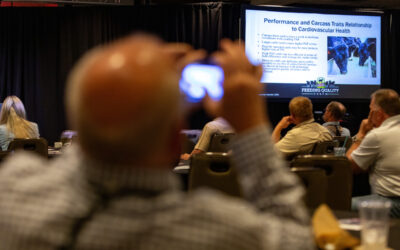
Finding Profit
by Miranda Reiman
Opportunity. It’s there, but you may have to look a little harder for it.
That’s what this year’s Feeding Quality Forum attendees learned during the daylong meetings on Aug. 29 in Omaha, Neb., and repeated in Garden City, Kan., Aug. 31.
AgResource Company kicked off the forum with market predictions.
Its president, Dan Basse, told Omaha attendees, “Ag is not at its bottom yet, but I think the worst is over.”
In the next few months, the analyst predicted fed cattle prices will hit bottom at $100 to $104 per hundredweight (cwt.), but improve into the first quarter of 2018.
USDA’s corn yield prediction at 169.5 bushels per acre (bu./acre) is more optimistic than Basse’s estimate of 165 bu./acre. Feeders might want to lock in feed costs now before there’s an incentive for a price increase, he said, noting $3.45 to $3.35 as an opportunity.
“The strategy is to find grain now, extend coverage. Perhaps don’t sell your cattle just yet if we’re looking forward into 2018,” said Ben Buckner, the AgResource analyst who carried the company message to Garden City.
Being proactive was a theme, as Doug Stanton, vice president of Where Food Comes From, talked about value-added opportunities.
U.S. beef going into Chinese markets is a hot topic that the third-party verification provider—IMI Global is a subsidiary—has been fielding questions on lately.

Traceable source of origin is the first step, Stanton said, along with no implants or beta agonists. Ranchers and cattle feeders wanting to target that market were advised to compare notes with potential buyers in advance.
“If you want to get involved in China, you better be talking with your packer you’ll be marketing to and see what their requirements will be,” he said.
Sharing information usually works for the good of all.
That was the intention behind USDA’s Mandatory Price Reporting, first introduced in the late 1990s, said Iowa cattleman Ed Greiman. The feeder was drawing on his experience as chairman of the cattle marketing committee for the National Cattlemen’s Beef Association (NCBA).
istering those shots.

Today the 20% to 30% of cattle traded live and represented in the report sets the base price for the remaining 70% to 80% sold on grids and formulas. It’s not always an accurate reflection of all fed cattle offered for sale in a week’s time, Greiman said.
“When you see that information, you don’t know what was being bought or how that trade was made,” he noted.
Yet, increasing the number of cash trades isn’t feasible when feeders have invested in premium calves and need to market them as such.
“CAB (the Certified Angus Beef ® brand) has done all this work to make sure the consumer wants the product, so we’ve got to produce more of them,” he said, suggesting cattlemen get involved in determining a new way to set base prices.
But long before marketing, feeders have decisions to make that will affect profitability.
It all starts with sourcing the right ones, said Justin Sexten, CAB’s director of supply development.
“There are cattle you want to own, and probably some you want to buy at a discount,” he said, noting all the variation in feeder calf supplies.
“There’s a lot of emphasis on flesh, precondition, where cattle come from—you name it—those each may account for $2 to $4 per hundredweight of the variation in cattle price,” he said.
But genetics make up a bigger difference in final profit.
“From a genetic perspective, there’s a $4 to $14 [/cwt.] difference out there from average genetics to exceptional,” he said, using an Angus example.
Once those cattle are in the feedyard, performance becomes a big driver of profitability.
Richard Zinn, University of California-Davis ruminant nutritionist, talked about how to increase that, predictably.
“The single most important factor affecting animal performance is energy intake,” he said. “And the link between intake and growth is perhaps the most reliable concept in cattle feeding.”
That allows for predicting accurate daily gains given gender, frame, weight and diet, Zinn said, adding these concepts are “nested in what we expect and how much results can vary before triggering alarm.”

During lunch, Lee Borck accepted the FQF Industry Achievement Award. With the help of Tyson and Performance Food Group, the meal featured Certified Angus Beef ® brand strip loin roast from cattle fed at one of Borck’s Beef Marketing Group partner yards.
More than 200 people attended the meetings, which were co-sponsored by Zoetis, Roto-Mix, IMI Global, Micronutrients, Feed-Lot Magazine and CAB
You may also like
Consumer Demand, Power of Quality
Demand for high-quality beef persists. But with that demand comes challenges. From tight cattle supplies to higher costs and increasing pressure on retailers to deliver a consistent eating experience, the pressure is on. David O’Diam, CAB VP of retail, addressed the current retail beef environment, highlighting both opportunities and challenges in today’s marketplace.
Data-Driven Progress and Partnerships
Discussions at Feeding Quality Forum reaffirmed the industry’s commitment to quality, transparency and innovation. With record Prime rates and strong consumer demand, producers who invest in genetics, health and relationships are positioned to drive progress and capture premiums.
Better Cattle Bring Opportunity
Cattle keep getting better, but that doesn’t mean producers should slow down progress. That’s what attendees took home from the 2025 Feeding Quality Forum. It’s call to action for the entire beef industry. Better cattle, yet new and old challenges for each segment.



